Recipes
Tried and true, these are some of my favorites, and some newbies. Come eat virtually with me!
- Arts and Crafts, Breads, Cake, Condiments, Dessert, Fruit, Gardening adventures, Herbs, Vegan, Vegetables, Vegetarian
2016 Marketplace and Last Tours of the Year
Our Marketplace is extended to Sunday, Nov. 20th, 9 – 2!
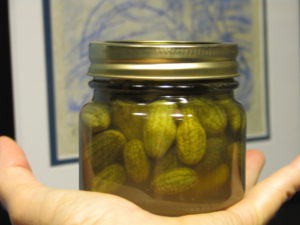 At Finch Frolic we’ve come to celebrate the end of our season with a Marketplace. This year our Marketplace will happen one day only, this Sat. Nov. 19th from 8-3. Finch Frolic is located at 390 Vista del Indio, Fallbrook, CA. We’ll be selling our abundance. Here’s some of the goodies you’ll find:
At Finch Frolic we’ve come to celebrate the end of our season with a Marketplace. This year our Marketplace will happen one day only, this Sat. Nov. 19th from 8-3. Finch Frolic is located at 390 Vista del Indio, Fallbrook, CA. We’ll be selling our abundance. Here’s some of the goodies you’ll find:Tiny Cocktail Mouse Melons (cucumbers… so cute!)
Amazing, milk-free Passionfruit Curd
Incredible tropical Guava Jam
Pickled Garlic
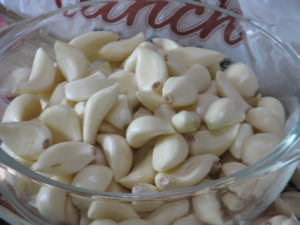
Whiskey Cranberry Relish
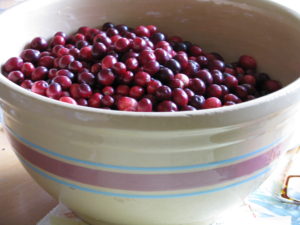
Nectarine Amaretto Jam
Tangy Plum Jam
Our very best dill Pickles

Jelly Palm Jelly
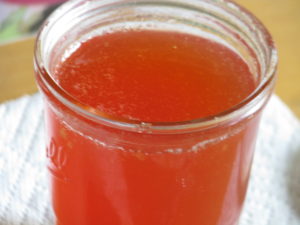
Spicy Jalapeno Carrots
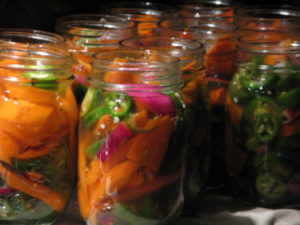
Hand-grated, homegrown organic Horseradish Sauce
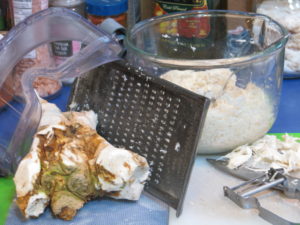
Guava Halves in Simple Syrup
Guava Paste squares – eat as is or put them in baked goods, or pair with slices of cheese. Ummm!
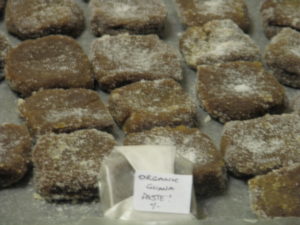
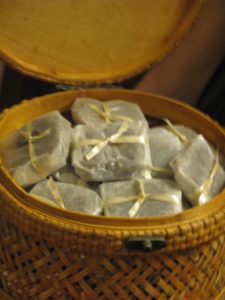
Frozen Passionfruit Juice cubes
Our famous Pomegranate Gelato
Frozen Pomegranate Arils, all ready to sprinkle on your baked goods or mix in a salad or stuffing.
Clear, amazing Guava Jelly
Frozen Plum, Guava and Peach slices
Frozen strained cooked organic home-grown pumpkin, all ready for a pie or bread!
Our best-selling Cranberry Biscotti
Gingerbread Houses. Pair them with our Passionfruit Curd for a memorable dessert!
Lilikoi (Passionfruit) Poundcakes. Small amazing tropical bundles of yum.
Guava Sauce, like applesauce but guava. Very low sugar!
Fresh Jerusalem Artichoke (Sunchoke) roots. Cook them or plant them!
Layered Curry Mix – a sensual trip to the Middle East, either layered in cute little jars for a gift or in bags for use at home. Make a curry with these organic spices!
Lime Juice Cubes
Candied Orange Peels. From our organic oranges. A much better stocking stuffer than hard candy. Or top your baked goods with a twist.
Fresh, fragrant guavas, both white and pink

Fresh kiwanos, those thorny African fruit that sell for a fortune at the stores.
And more!
Plus, we’ll be selling some knick-knacks, and a few garage sale items . A punching bag anyone?
PLUS, we’ll have a selection of native plants lovingly grown locally.
And we’ll have amazing succulents from our neighbor Rosa of Roja’s Succulents. You’ll pass by her business on the way in, so please stop by on the way out and see her incredible inventory of plants, all organically hand-grown by Rosa. I never loved succulents until I saw her collection, and her very low prices!
Except for the gelato, we’re dairy (milk) free this year. We use organic eggs from cage-free hens, and otherwise use vegan butter that I make at home which is coconut-oil and rice milk based.
Our last two tours of the year (the garden closes from Thanksgiving until March 1. We will still be available for consultations and appearances) will be this weekend, Nov. 19th and 20th, both at 10. [UPDATE: THE SATURDAY TOUR IS FULL. THERE IS STILL ROOM FOR THE SUNDAY TOUR]. The tours are our usual 2-hour concentrated Intro to Permaculture walks through the garden. The tours cost $15/adult and you will come away with so many ideas and so much information that you’ll spend the next week working in your garden! Please RSVP for the tours to dianeckennedy@prodigy.net.
Your continued support helps Miranda and I keep our consultation and tour prices low, and enables us to keep teaching and spreading the word on permaculture. So thank you!
-
Adventures with Fruit: Pindo (Jelly) Palms
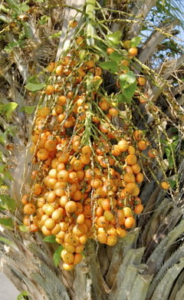 Evaluating the usefulness of the plants in your yard is a big part of permaculture; once you understand what each plant does, you will know if it is useful either to you, to wildlife or to the environment, or if it is causing harm. There are many food-producing plants that we think of as weeds or as ornamentals. Always, always, always be sure before you pop something in your mouth. So by identifying your plants you can add to your diet, and if something is already successfully growing in your yard and you can use it, fantastic!
Evaluating the usefulness of the plants in your yard is a big part of permaculture; once you understand what each plant does, you will know if it is useful either to you, to wildlife or to the environment, or if it is causing harm. There are many food-producing plants that we think of as weeds or as ornamentals. Always, always, always be sure before you pop something in your mouth. So by identifying your plants you can add to your diet, and if something is already successfully growing in your yard and you can use it, fantastic!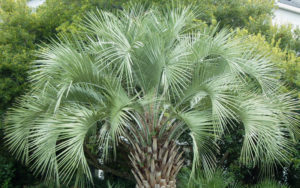 You’ve probably walked past them, or even looked askance at the dropped fruit without realizing. Also called Jelly Palms, the pindo palm is a common landscape tree for drought-tolerant hot areas. The fronds look very pokey, but are rather soft. That is a relief because once you’ve tasted the ripe fruit you’ll be thrashing through the fronds trying to pick more of them.
You’ve probably walked past them, or even looked askance at the dropped fruit without realizing. Also called Jelly Palms, the pindo palm is a common landscape tree for drought-tolerant hot areas. The fronds look very pokey, but are rather soft. That is a relief because once you’ve tasted the ripe fruit you’ll be thrashing through the fronds trying to pick more of them.Pindo palms (Butia capitata) are called Jelly Palms because the fruit has a lot of pectin in them. The trees are also called Wine Palms because you can make a cloudy wine from the fruit. But then, mankind has proven that you can make alcoholic beverages from just about anything.
The fruit is small and fiberous with a big seed, and falls to the ground when very ripe. They taste amazing. The burst of flavor is as if a pineapple and an apricot had a little yellowish baby. The best way to eat them is to gently chew the whole thing and swallow the juice, then spit out the fiber and seed.
We have two jelly palms at Finch Frolic Garden, only because they didn’t have identification we didn’t really know what they were. At the beginning of this year Miranda and I were evaluating the garden plants using the Three Positives rule (where everything in the garden has to give you three positive things. If it doesn’t, then it should be turned into hugelkultur or mulch). Several trees were repurposed and we were eyeing the palms. These palms are squat and short, not slim and tall like the very similar Queen palms. Fortunately for them, and as it turned out, for us, the trunks were too thick for my small chainsaw so we didn’t remove them with the others. This threat seemed to work because they set fruit on long stalks. We hesitantly tried one… and then just about ran each other over trying to get more!
Queen palms also produce an edible fruit that is sweeter, but is only edible when very ripe.
The fallen ripe fruit can attract bees and wasps because, well, everyone wants some. We waited until the stalks were just about completely ripe then cut them off and left them in a paper bag. The fruit then ripened and dropped off in the house where we could have them all.
Most of what I know about the Pindo Palm comes from the website Eat the Weeds by Greene Deane.
We cleaned them and froze them. Now we’re making Pindo Palm Jelly. Or maybe Jelly Palm Jelly, which sounds better.
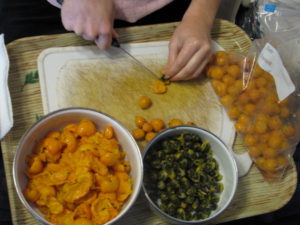 Freezing and thawing the fruit actually helps break down some of the fiber and release juices, and makes them much easier to pit. The pits are high in oil, so advice for cooking the fruit whole says the jelly can pick up bitter flavor from the seeds. We sat with trays laden with cutting boards, a knife and bowls and pitted them. Yes, this is how we spend our evenings when I’m not out dancing, processing fruit and watching a movie or reruns of the Bob Newhart show or something. Yep.
Freezing and thawing the fruit actually helps break down some of the fiber and release juices, and makes them much easier to pit. The pits are high in oil, so advice for cooking the fruit whole says the jelly can pick up bitter flavor from the seeds. We sat with trays laden with cutting boards, a knife and bowls and pitted them. Yes, this is how we spend our evenings when I’m not out dancing, processing fruit and watching a movie or reruns of the Bob Newhart show or something. Yep.The thawed fruit was easy to push away from the seed, so the process went very quickly although our fingers were pretty cold from the fruit.
We covered the pitted fruit with water and cooked it for about an hour, then strained out the fruit. There isn’t a lot of pulp because of all the fiber.
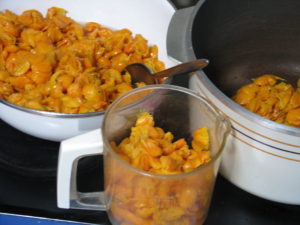 We used the National Center for Home Food Preservation’s recipe which used a lot of sugar, but the juice is so tart that it needed it.
We used the National Center for Home Food Preservation’s recipe which used a lot of sugar, but the juice is so tart that it needed it.What we got was a beautiful jelly that,despite the natural and added pectin was fairly loose. The benefit was that it can be used as a syrup as well. While the flavor of the jelly isn’t quite as astonishing as the fresh fruit, the tart tropical flavor is very good.
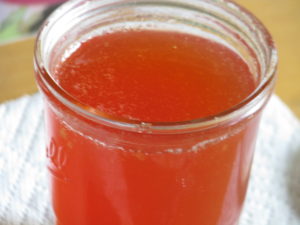
So walk around your weeds and trees and identify them, read up on them, and perhaps you can find a treasure in your yard as we have!
(We’ll be selling Jelly Palm Jelly at our annual Marketplace here at Finch Frolic Garden on Sat. Nov. 19th, 2016)
-
Ghostly Spring Rolls
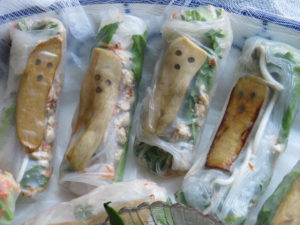 Vegetariat began as mostly a food blog. Now I talk more about growing food than cooking but if you go through the archives you’ll find a lot of recipes. This one I thought was so cute that I had to pass it on.
Vegetariat began as mostly a food blog. Now I talk more about growing food than cooking but if you go through the archives you’ll find a lot of recipes. This one I thought was so cute that I had to pass it on.
My daughter and I wanted something savory, vegan and spooky to bring to a Halloween potluck. We saw lots of Pintrest tags for apple slices with teeth, green pepper faces oozing spaghetti and all kinds of cheese or egg eyeballs.
Miranda had made some Thai spring rolls for my birthday last week, which are a big favorite of mine. I liked how you could see the veggies through the rice paper. Then I thought what if something spooky was peering through the rice paper wrapper? A ghostly figure. Then I thought of these wonderfully large King Oyster mushrooms we bought at 88Ranch Market and I knew what I wanted.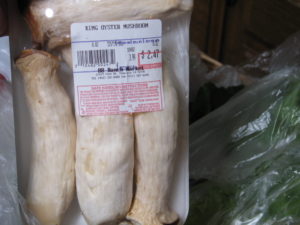
I sliced the mushrooms very thinly.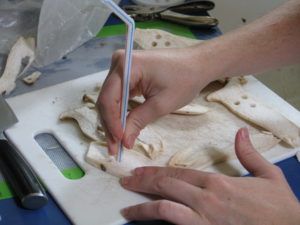 To cut out the eyes and mouth at first I used a knife, then tried a hole punch, and finally used the end of a plastic straw which worked beautifully.
To cut out the eyes and mouth at first I used a knife, then tried a hole punch, and finally used the end of a plastic straw which worked beautifully. I simmered the mushrooms until tender in vegetable broth, sesame oil and Bragg’s Amino Acids.
I simmered the mushrooms until tender in vegetable broth, sesame oil and Bragg’s Amino Acids.  Then they were set on paper towels to dry and to cool. We also prepared the other ingredients: cilantro, Thai basil, strips of chive, soaked rice noodles, lettuce, bean sprouts, grated carrot and crumbled tofu cooked in sesame seed oil and lite Soy Sauce.
Then they were set on paper towels to dry and to cool. We also prepared the other ingredients: cilantro, Thai basil, strips of chive, soaked rice noodles, lettuce, bean sprouts, grated carrot and crumbled tofu cooked in sesame seed oil and lite Soy Sauce.
Spring rolls are not cooked. They are a bunch of flavorful and aromatic herbs and veggies wrapped in a clear rice paper wrapper. These wrappers come in hard, brittle sheets. You carefully dip them one at a time into hot water and they quickly become translucent and soft.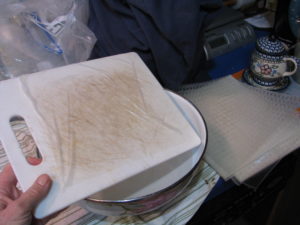 This is the tricky part, getting them on a surface to fill and fold without allowing it to stick onto itself. If one hangs up too much, dip it back into the water and you can gently pull creases out then.
This is the tricky part, getting them on a surface to fill and fold without allowing it to stick onto itself. If one hangs up too much, dip it back into the water and you can gently pull creases out then.
We put a mushroom ghost 2/3rds of the way up, and the rest of the filling just below that.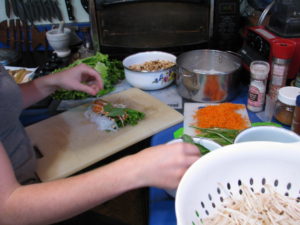 Don’t overfill, and keep a margin on either side for folding. Beware of stems that might poke holes into the wrapper. To fold, you fold in either side first. Then fold the bottom up until it covers 2/3s of the rest, then roll up. The filling should be neatly tucked away and the ghost peering out. You can arrange the filling behind the ghost so that there are different backgrounds, such as a lettuce forest, creepy bean sprout tendrils or a haze of red carrot.
Don’t overfill, and keep a margin on either side for folding. Beware of stems that might poke holes into the wrapper. To fold, you fold in either side first. Then fold the bottom up until it covers 2/3s of the rest, then roll up. The filling should be neatly tucked away and the ghost peering out. You can arrange the filling behind the ghost so that there are different backgrounds, such as a lettuce forest, creepy bean sprout tendrils or a haze of red carrot.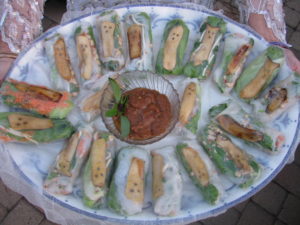
Serve the rolls with a peanut dipping sauce. We brought these to a potluck Halloween party and they all disappeared in a not-so-spooky manner!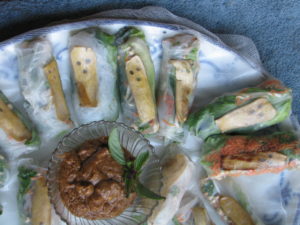
If you don’t have big mushrooms available, then you can also do this with carrots very thinly sliced and handled the same way.
Here’s a quick recipe for the peanut dipping sauce, but there are many variations out there so try others:
Peanut Dipping SauceRecipe type: SauceCuisine: ThaiPrep time:Total time:Serves: ½ cupFor use with Thai spring rolls.Ingredients- 2 tbsp water
- ½ cup chunky peanut butter (you can use smooth, but I like the chunks for more flavor)
- 1 tbsp sugar
- 4 tbsp vegetarian hoisin sauce
- 1 tbsp lite soy sauce (or Bragg's Amino Acid)
- 2 small garlic cloves (or 1 large), minced
- 1 birds eye chilli, finely chopped (optional. We left them out)
- 1 tbsp sesame oil
- 2 tbsp lime juice
Instructions- Mix all ingredients until the consistancy is like honey; you want it to stick but not clump.
- Garnish with crushed peanuts and sprigs of herbs or a piece of lime.
Just wanted to share our spooky treats that also were very healthy and so very tasty!
-
Happy Autumn!
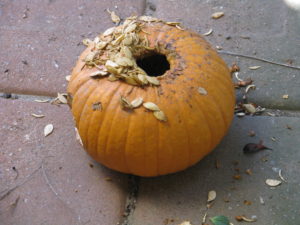 Some night creature has been enjoying our pumpkins… if I see a Jack O’Lantern face being chewed into the side of it, then I’ll be setting up the night camera!
Some night creature has been enjoying our pumpkins… if I see a Jack O’Lantern face being chewed into the side of it, then I’ll be setting up the night camera!Update: I suspected that this was the culprit! Bon appetite, Madam Rat.




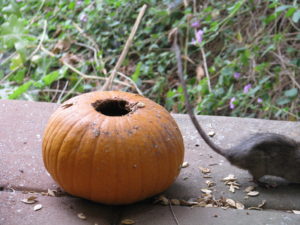
- Dessert, Fruit, Gardening adventures, Herbs, Special Events, Spices, Vegan, Vegetables, Vegetarian, Water Saving
Our Annual Marketplace, and Last Tours of 2015
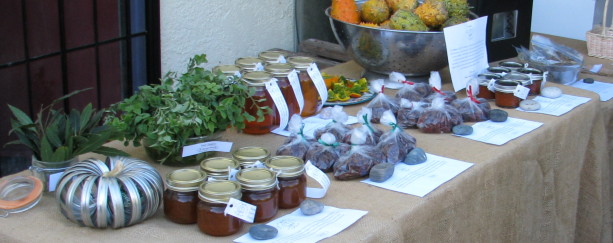 Our fourth-annual Finch Frolic Marketplace will take place Nov. 21 and 22nd from 9 – 2. We’ve been working like little permaculture elves, harvesting, preparing fruit and vegetables, canning, baking, and inventing new recipes for your table and for gifts. We have a curry spice mixture that is amazing. Our record white guava harvest has allowed us to create sweet guava paste and incredible guava syrup. We’ve pickled our garlic cloves, as well as zucchino rampicante, and our Yucatan Pickled Onions have a wonderful orange and oregano base that is fabulous. Of course there is Miranda’s small-batch Pomegranate Gelato, Whiskey-Baked Cranberry Relish, and a selection of curds (passionfruit, lemon-lime, and cranberry). So much more, too. We’ll also be selling plants from several sources, and some collectibles and knick-knacks from my home. Please come support a small business early – a whole week before Small Business Saturday! Your patronage allows us to continue teaching permaculture.
Our fourth-annual Finch Frolic Marketplace will take place Nov. 21 and 22nd from 9 – 2. We’ve been working like little permaculture elves, harvesting, preparing fruit and vegetables, canning, baking, and inventing new recipes for your table and for gifts. We have a curry spice mixture that is amazing. Our record white guava harvest has allowed us to create sweet guava paste and incredible guava syrup. We’ve pickled our garlic cloves, as well as zucchino rampicante, and our Yucatan Pickled Onions have a wonderful orange and oregano base that is fabulous. Of course there is Miranda’s small-batch Pomegranate Gelato, Whiskey-Baked Cranberry Relish, and a selection of curds (passionfruit, lemon-lime, and cranberry). So much more, too. We’ll also be selling plants from several sources, and some collectibles and knick-knacks from my home. Please come support a small business early – a whole week before Small Business Saturday! Your patronage allows us to continue teaching permaculture.
Join us for a tour! Our last two Open Tours will also be held that weekend, each at 10 am. The tours last about two hours and we should be having terrific weather for you to enjoy learning basic permaculture as we stroll through the food forest. Please RSVP for the tours to dianeckennedy@prodigy.net. More about the tours can be found under the ‘tours’ page on this blog.
Finch Frolic Garden will be closing for the winter, from Thanksgiving through March 1. However, Miranda and I will still be available for consultations, designs, lectures and workshops, and we will be adding posts to Vegetariat and Finch Frolic Facebook (you don’t need to be a member of Facebook to view our page!).
Have a very safe and very happy holiday season. Care for your soil as you would your good friends and close family, with swales, sheet mulch and compost, and it will care for you for years.
Diane and Miranda
- Animals, Compost, Fungus and Mushrooms, Gardening adventures, Heirloom Plants, Natives, Other Insects, Perennial vegetables, Permaculture and Edible Forest Gardening Adventures, Pets, Predators, Recipes, Reptiles and Amphibians, Seeds, Soil, Worms
Argentine Ants
Most of the annoying ants we suffer with in California, especially here in San Diego, are actually an invader called Argentine Ants. They arrived via shipboard to Louisiana, and have spread throughout warmer climates. Argentine ants are so successful because they have multiple queens per colony and therefore recognize all other Argentine ants as family. They don’t fight among themselves. There is a colony that stretches from San Diego to near San Francisco.
Argentine ants have nudged out many of our native ants, which isn’t a good thing. We need our native ants for decomposition. Argentine ants harm arthropods and have a terrible effect on the ecosystem; here in Southern California their impact on horned lizards have been devastating. The only way you can tell them apart (unless you have very tiny ants or black or red ants) from natives of similar size is by studying them with a microscope. This blog post shows great photos of the difference between ants.
Argentine ants farm aphids on plants and trees, milking the bugs for their ‘honeydew’, a sweet excretion. They will bring aphids to your plants and farm them there. They will also farm scale underground around the trunks or stems of plants, especially natives such as California Lilac (ceanothus spp). By the time the plant show stress and the ants begin to farm aphids above ground, much of the damage has already been done.
As much against annihilation as I am, this ant does terrible harm to our environment and should be happily living back in its native South American river area. Not only is it directly harmful, but because it is everywhere it incites people to spray poisons that kill all the beneficial insects as well.
The best solution is a borax bait trap that you can make your own. Borax is a powerful killer and should not be used liberally. Yes, it is sold as a fertilizer and as a laundry additive, and that borax kills insects and beneficial flora and fauna as it enters the watershed and soil. It is toxic to pets and children. However, just a little solution used wisely can really help control these ants.
I use old spice containers that have the plastic shaker ends on them for the bait traps. The holes are small enough to prevent other insects or animals from entering the jar, but are big enough for the ants. Otherwise you can use butter tubs with small holes punched in the top. Put a cotton ball inside the containers.
It is recommended to make a 1% borax solution rather than a stronger one because you don’t want to kill the ants immediately. You want them to bring the bait back to the nest and feed it to the queen. I know that is horrible, but they would definitely do the same to us if they could.
This recipe is based on research done by entomologist John Klotz at UC Riverside. Dissolve 1 tsp. boric acid (borax) and 6 tablespoons sugar in two cups of warm -preferably distilled or dechlorinated – water. Soak cotton balls in the bait solution and place in spice shakers or plastic tubs with holes in the lid. The containers will also keep the cotton ball from drying out quickly. Place in a shady location in the path of Argentine ants. Clean the container and replace the cotton ball weekly (it will become moldy). At first the bait traps will attract more ants, which is fine because they are bringing the bait back to their nests. If you want to kill the ants immediately, add more boric acid. For long-term control, reduce the boric acid to 1/2% to allow worker ants to feed for a long time before they die and therefore bring more back to the nest.
Keep the excess boric acid solution capped and in the refrigerator well labeled, so no one drinks the sweet drink.
Be sure to keep an eye out for ant activity around the base of your native plants, and if you have aphids on the leaves of plants you no doubt have ants farming them there. Argentine ants are pests we really can eliminate without fear, and allow our native ants to reclaim their territory.
- Animals, Bees, Birding, Compost, Fungus and Mushrooms, Gardening adventures, Health, Heirloom Plants, Houses, Hugelkultur, Microbes and Fungi, Natives, Other Insects, Perennial vegetables, Permaculture and Edible Forest Gardening Adventures, Ponds, Predators, Quail, Rain Catching, Recycling and Repurposing, Reptiles and Amphibians, Soil, Vegetables, Water, Water Saving, Worms
My Plea Against Gravel
 Here in Southern California, as in many other areas, we are finally legally recognizing the drought. There are rebates in place for those who take out their lawns, and here in Fallbrook there is a 36% water reduction goal. Many people just don’t know what to do with all that lawn. A very unfortunate continuing trend is to dump half a ton of colored gravel on it. Please! NO! First of all, once down gravel is nearly impossible to get out again. Gravel, like all rocks, is thermal mass. Instead of having a large rock heating up and radiating out heat, with gravel there are tens of thousands of surfaces radiating out heat and reflecting light and heat back up. It is the worst kind of hardscape. All that reflected heat and light heats up your home, making you use your air conditioner more frequently which is a waste of energy, and also dries out the air around your home. Desertification reflects light and heat to a point where moist air moving over a region dries up. There is less rain, or no rain. Most trees and plants trap humidity under their leaves. Gravel reflects light and heat back up under those leaves and dries them out, sickening your plants and trees. Pollen travels farther on humid air; it can dry out quickly. If you are relying on pollination for good fruit set between trees that are spaced far apart, then having some humidity will increase your chances of success.
Here in Southern California, as in many other areas, we are finally legally recognizing the drought. There are rebates in place for those who take out their lawns, and here in Fallbrook there is a 36% water reduction goal. Many people just don’t know what to do with all that lawn. A very unfortunate continuing trend is to dump half a ton of colored gravel on it. Please! NO! First of all, once down gravel is nearly impossible to get out again. Gravel, like all rocks, is thermal mass. Instead of having a large rock heating up and radiating out heat, with gravel there are tens of thousands of surfaces radiating out heat and reflecting light and heat back up. It is the worst kind of hardscape. All that reflected heat and light heats up your home, making you use your air conditioner more frequently which is a waste of energy, and also dries out the air around your home. Desertification reflects light and heat to a point where moist air moving over a region dries up. There is less rain, or no rain. Most trees and plants trap humidity under their leaves. Gravel reflects light and heat back up under those leaves and dries them out, sickening your plants and trees. Pollen travels farther on humid air; it can dry out quickly. If you are relying on pollination for good fruit set between trees that are spaced far apart, then having some humidity will increase your chances of success.
An area of Wildomar, surrounded by hillsides of chaparral that hasn’t been destroyed. These homes have mostly gravel yards and denuded, compacted backyards. Very little rain penetrates, and all the weeds that nature sends it to help repair this gash in the earth are promptly poisoned. This is death to us and our planet. By laying gravel you are turning soil into rock-hard dirt, because microbial life cannot live closely under it. That robs any plants you have stuck into the gravel of the food they need from the soil, which is opened up through microbial activity. You are adding to the heat value of the hardscape around your house causing you to cook in the summer and use more air conditioning. You have reduced habitat to zero. You have added to global warming by reflecting more heat and light into the sky. Although gravel is permeable, usually the ground below it bakes so hard that rain doesn’t percolate. I’ve read sites that want to you increase the albedo effect by laying gravel. In the short term albedo helps cool the atmosphere, but as a result of too much reflected light dries everything out. Think of the dark coolness and dampness of forests… that are now bare ground.
What do you do with your lawn instead? There are many choices that are so much better for the earth and your quality of life. First step, cut swales on contour on any slopes for best rain harvesting. Flat lawn? Easier still. Turn your lawn into a beautifully landscaped lush native garden. I’m not talking about a cactus here and there, but a creation with the awesome native plants we have in Southern California. Some of them such as Fremontia can die with supplemental summer water!

A beautiful border and plantings of California natives. Very low water use here, and very high habitat! There is a chocolate daisy that smells like chocolate. Oh yes. And how can you not want to plant something called Fairy Duster or Blue-Eyed Grass? A native landscape planted on soil that has been contoured to best catch and hold water, and amended with buried wet wood (hugelkultur), will give much-needed food, water and breeding grounds to countless birds, butterflies, native insects and honeybees.
Or put in a pond. Wait, a pond during a drought? Yes! Ninety-nine percent of California wetlands have been paved over, drained or are unusable. Where are all the animals drinking? Oh, wait, we are in the epicenter of extinction, mostly due to wetlands loss. There are very few animals left that need to drink. Those that are left have to take advantage of chlorinated water in bird baths and swimming pools. The microbially rich and diverse clean, natural water that fed and sustained life is just about gone. So what can you do? If you have a swimming pool, you can convert it either entirely to a pond, or into a natural swimming pool that is cleaned by plants.
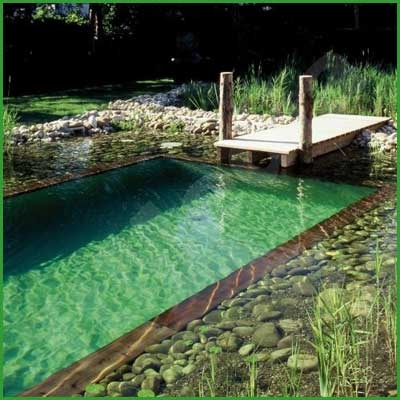
A natural pool upgrades your pool to a lovely pond without the use of chemicals. Suddenly instead of having this expensive eyesore that you use only a couple of months a year and pour chemicals into year-round, you have a lovely habitat that you want to sit and watch, and even better, swim in safely without turning your hair green or peeling your skin. You don’t need to clean the pool all the time, and you don’t need to put in chemicals. If you are in the San Diego or Los Angeles area, call Dr. Robert Lloyd of PuraVida Aquatics for a consultation and conversion. If you don’t have a pool, then build one that is cleaned by plants and fish. You don’t need a filtration or oxygenation system because the biology does it all. Where do you get the water from to top off your pond?
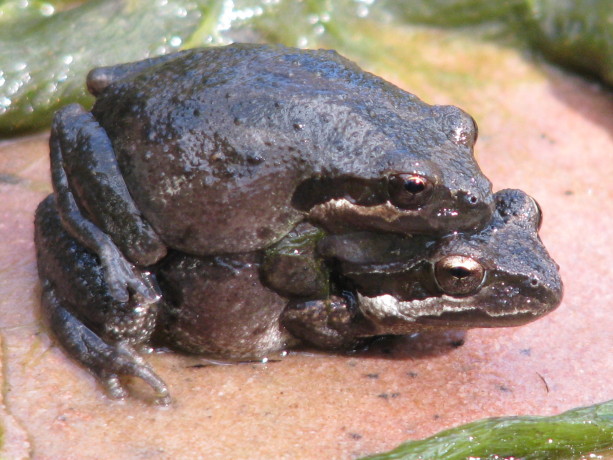
Native Pacific Chorus Frogs enjoying our clean pond at Finch Frolic Garden. Connect your pond to a lovely, planted stream that is connected to your laundry water or graywater system. You are buying water every day, so why not compost your water through phytoremediation and have a pond full of great healthy chemical-free water that is wonderful to look at and is an oasis for thirsty animals and insects?
Or install a food forest. With good soil building and rain catchment first, and planting in guilds with sheet mulch around trees and on pathways, you will be using a fraction of the water you pour on your lawn and yet harvest lots of food. Too much food? Share it with a food pantry!
Or start a veggie garden without digging any sod.

Create a lasagna garden right on top of the lawn and start growing immediately. Layer cardboard, sticks, grass, food scraps, leaves, more grass, more food scraps, more leaves and top it with about 8 inches of good soil, then plant right in it! That lovely standing compost heap will slowly turn into good soil while killing the grass beneath and growing crops for you immediately.
If ridding yourself of a lawn just breaks your heart, then substitute the high-water use grasses for a native grass mix that is comparable. Look at S&S Seeds for prices or for seed choices. Water a few times with Actively Aerated Compost Tea using any rainwater you may have caught in those 50-gallon containers and your grass roots will travel so deeply that they will find groundwater. Check up on the work of soil microbiologist Dr. Elaine Ingham and see how easy AACT is to make and use.
There are so many alternatives to using gravel that aren’t expensive, that are an investment in your property and in reclaiming habitat while beautifying your home and saving money. So please, just say, “NO,” to the gravel. Tell a friend!!
Which one of these would you rather live in? Which do you think is better for the earth and for the future generations?

Finch Frolic Garden, year 3. - Animals, Bees, Birding, Chickens, Compost, Fungus and Mushrooms, Gardening adventures, Heirloom Plants, Hugelkultur, Microbes and Fungi, Natives, Other Insects, Perennial vegetables, Pets, Predators, Rain Catching, Recycling and Repurposing, Reptiles and Amphibians, Seeds, Soil, Vegetables, Water Saving, Worms
Pathways Can Help Your Garden!
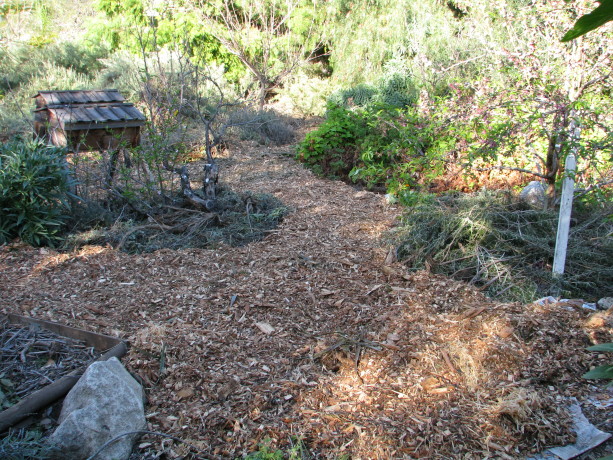
A finished section. Footpaths and/or vehicle access paths are absolutely necessary for any yard. Unfortunately, weeds love growing in them. Worse, the pressure from footfalls, wheelbarrows and vehicles compress and compact the soil, pressing the soil grains together so tightly that oxygen – and therefore life – can’t exist often up to several inches or more deep. Any life, that is, except for the grasses and other weeds that nature sends in to help repair the soil. Bare ground will be greatly compacted by rainfall, which will then erode paths as it runs, unable to soak through that spaceless ground. Once wet bare pathways are often unwalkable until they dry out, and have to be resmoothed. In our hot, dry areas, bare earth or graveled pathways reflect heat and light back up. That reflected heat and light dries out the underside of plant leaves, where species such as Live Oaks have over the millennium developed leaves that curl to expose less surface to the hot sun and to gather moisture underneath. Reflected heat and light dries out the air as well, and any hope of slight humidity to help water plants through months of dry heat is gone. If you have open-pollinated vegetables that rely on breeze for pollination, all that open pathway actually decreases your germination because pollen – such as from corn – will dry out in arid conditions. Humidity that you can keep in your garden will keep pollen more viable longer.

A wealth of freshly chipped wood – two dump-trucks full! The challenge: to spread it all in a week before our first tour. Yikes! What to do? Covering pathways with gravel is a common solution. I hate gravel. It heats up and becomes a thermal mass in the summer, further cooking your soil and air. It doesn’t suppress weeds and weed-whipping becomes an exercise in avoiding shrapnel. You can never get it out of the ground once you apply it, and chunks of gravel don’t do soil much good for planting. If you trip and fall on gravel it does terrible things to your knees – I had a piece lodged in my kneecap after a stumble some years ago (sorry for that cringe-worthy item).
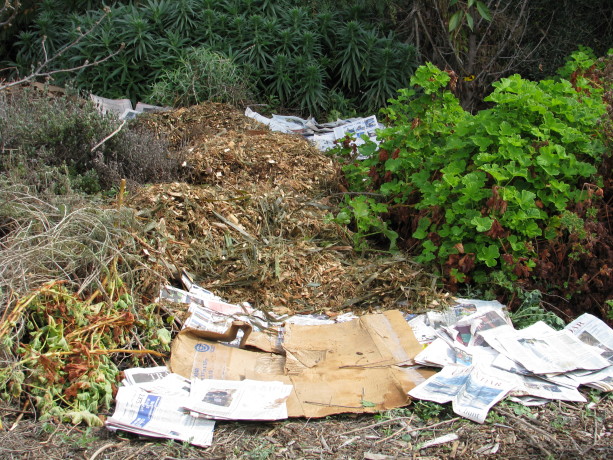
A 1/2 inch of cardboard or newspaper with mulch on top. Covering the soil is better, but not best. Bark will help rain bounce and then percolate, is dark so it won’t reflect light and heat as gravel does, and it decomposes. It is also expensive to buy, and because it decomposes you have to re-buy it every couple of years. Decomposing bark may be adding elements to your soil that you don’t want depending upon the source.
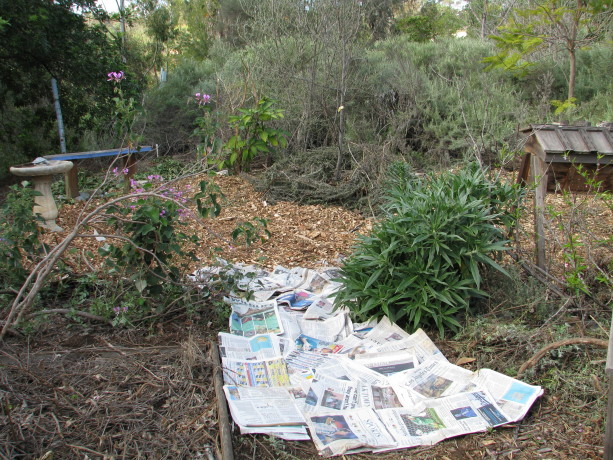
More progress as the afternoon wears on. I have experienced all the options above. The best method of countering all these issues that I have found also repurposes and recycles. Sheet mulch. Yep. You’ve heard it from me before and it proves itself every year. There is more to it, though.
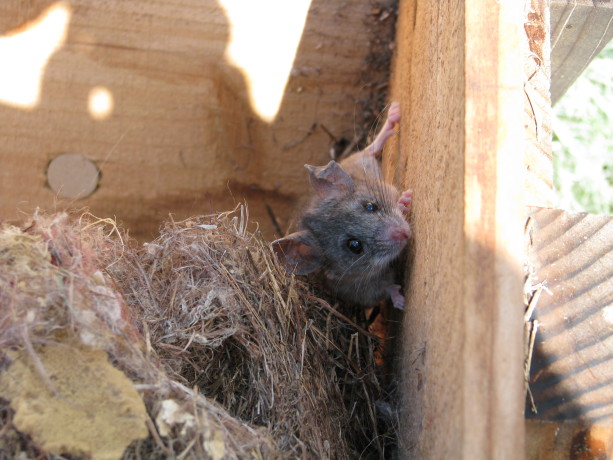
I disturbed a couple of nesting mice in one of the unused Kenya bee hives. First of all, please, please, please never use plastic. You can read about white pollution and the layers of plastic merging with topsoil in China and cringe. Plastic will not last. It will always be around in pieces. You will be poisoning your soil.
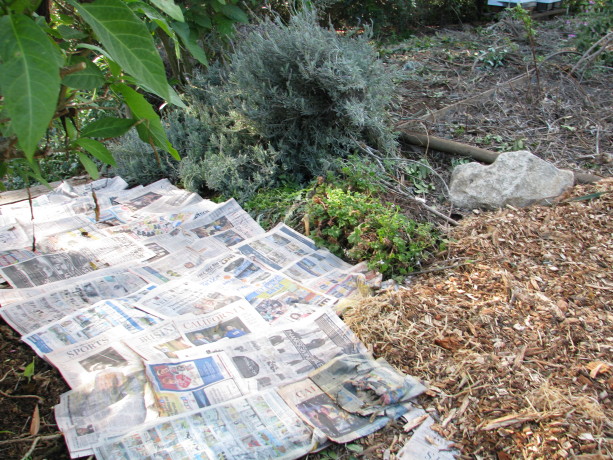
At the most basic, you can cover your pathways with 1/2″ of cardboard and newspaper, and top it with wood chips. I obtain my wood chips from arborists who save paying a dump fee by dumping it in my yard. If you’d rather have a more uniform look then purchase your bark. Either way the cardboard and newspaper will make the chips last years longer. More importantly the cardboard and newspaper form a protective, absorbent layer that protects the soil from compaction. Have you looked under a log or sheet of abandoned plywood in awhile? All the white tendrils of fungus, insects, worms, lizards and roots are thriving there along with billions of soil microbes all because they have that protective layer that keeps moisture in and compaction out. That microclimate is what you are forming with cardboard and mulch pathways. Since microbes free up the nutrients in the soil from which plants feed, you are creating more food sources for your plants. Tree and plant roots don’t end at the dripline, they reach out towards whatever source of water and nutrition they can find. If you are top-watering rather than deep-watering, then roots are abundant closer to the topsoil. By sheet mulching pathways you are extending food sources for your plants and trees, which now can stretch underneath the paths, link together with other roots through fungal networks, and become stronger and healthier. You also are creating habitat which is a food source for the entire food chain. Cooler, humid areas are better for bees and insects that pollinate, and the predators that feed upon them such as lizards, toads, frogs and birds. Just by sheet-mulching your pathways you are improving your environment as a whole. How can you NOT want to do this?

Sheet mulching around trees is much the same, except you add a little manure or compost tea if you have it. Sheet mulched pathways hold moisture and create some humidity which allows for better pollination and helps keep your plants from scorching in arid areas. If you live in a wet area or very humid area, use thicker layers of cardboard and mulch, which will help absorb moisture from the air and deliver it to the ground. Decomposition is quicker in wet areas, so using several inches of cardboard with mulch will last much longer and will again keep down compaction. Compaction in rainy areas is just as bad as in arid areas because of the erosion and flooding it causes.

More progress as the afternoon wears on. To catch rainwater and allow it to percolate into the soil rather than erode away topsoil, you dig rain catchment basins or swales. Swales are ditches with level bottoms, and can be a foot long (fishscale swales) or the length of your property. Swales should be positioned perpendicular to the flow of water. You can create swales across pathways, fill them with mulch, top them with cardboard or old plywood, and mulch on top to match the rest of the pathway. Water will be caught in the swales and won’t wash out paths on hillsides.
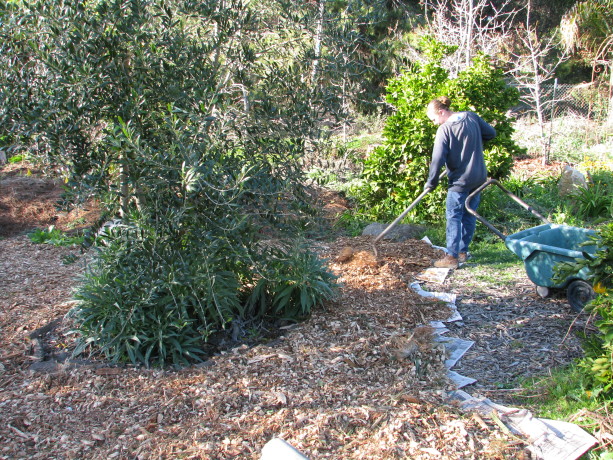
MIranda working on a large pathway near our large hugelbed. Going a step farther, you can ‘hugel swale’. Hugelkultur is layering woody material with dirt. This introduces organic material, oxygen and nutrient pathways into the soil and holds moisture into the dry season. You can dig deeply in your pathways, layer old wood (sticks, branches, logs, whatever you have) with the dirt, up to soil level, then sheet mulch. Your pathways are now waterharvesting alleys that you can walk on, and which will really feed your plants. And you just repurposed old woody cuttings.
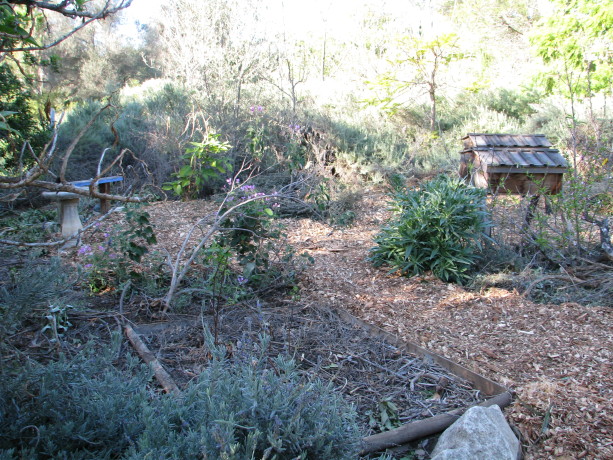
This mulch will greatly help the Asian pears and cherries which struggle with the dry heat of the summer. The ground will be kept moist and reduce evaporation, holding in humidity. We’ll be planting more heavily in this area, too. In very dry areas plants and trees do better in sunken beds, especially those that require a long chill time. Cold settles in holes. Moisture runs downhill, therefore dew will accumulate at the bottom of holes. You can either plant in holes and have your pathways higher, or if you have an established garden (such as I do) you can build up your pathways so that they become slightly higher than your trees and planting areas. We are working on that at Finch Frolic Garden, here in drought-stricken San Diego county.
So before I launch into yet another long lecture, the idea for pathways is simple: sheet mulch with cardboard and wood chips. If you live in a wet area, use several inches of both. If you live in a dry area, use no more than 1/2 inch of cardboard (or else it will absorb moisture from the soil) topped by at least an inch of mulch (no limit there!). If you want make super pathways, bury woody material before you sheet mulch. If you live in a dry area, raise your pathways above your planting beds. If you live in a wet area, lower your pathways so water can drain away from your plants (unless they love wet feet). Never use plastic, and please rethink gravel.
Then sit back and enjoy your yard and all the food and nutrients and abundance you have set the stage for, all using recycled materials that will last for years. Congratulations!
-
Vegan Turmeric Milk: A Yummy Cold Remedy

Gingery turmeric milk is a delicious powerhouse in the war against colds. Have a cold, or just near someone who has one? Headache? Aches and pains? Digestive problems? Here is a simple and very delicious East Indian recipe that mothers give their children when it is cold season. It contains some powerful anti-inflammatories, namely turmeric and ginger. I’ve written about how taking turmeric daily has kept my arthritic hands mobile and virtually pain-free. Look up the health uses for turmeric and you will be amazed. Black pepper helps activate turmeric, and since turmeric is fat-soluble it is best taken with a little fat in your meal. The following recipe can be made in a few minutes and feels wonderful going down. It was inspired by a post on Journeykitchen.com. I used organic vanilla soy milk, because that is what I had. You may use any dairy substitute that you want, but not non-fat. If it is non-fat, then add a half teaspoon of oil (such as coconut oil) to the drink, or eat some on the side.
I make a big pot of this in the morning, strain it and then rewarm it during the day as I need it. The longer you simmer the spices, the stronger they become. The ginger becomes a little hotter, and the others more bitter. For children or those new to these spices, heat the spices in the milk 3-5 minutes before straining unless they like it stronger.
Turmeric is a bitter yellow root that can be cooked with, or more commonly is found dried and ground to use in curries and as a colorant. Where do I even begin to list its benefits? As I previously mentioned turmeric is used for arthritis, heartburn , stomach pain, diarrhea, intestinal gas and bloating, loss of appetite, jaundice, liver problems and gallbladder disorders. It is also used for headaches, bronchitis, colds, lung infections, fibromyalgia, leprosy, fever, menstrual problems, and cancer. Other uses include depression, Alzheimer’s disease, water retention, worms, and kidney problems. Turmeric can be applied to the skin for pain, ringworm, bruising, eyeinfections, inflammatory skin conditions, soreness inside of the mouth, and infected wounds. It is used as a facial to help skin and give darker skin a glow (I used it on my pale face and came up yellow for a few washings, but with nice skin!).
Ginger helps with the symptoms of upper respiratory tract infection, bronchitis, cough, menstrual cramps, arthritis and muscle pain, but is especially known for relieving nausea. I ate a lot of ginger during my pregnancies, and now we have some in the car to treat motion sickness.
Adding organic honey as a sweetener really boosts the healing power of this drink. Honey – and not the processed mass-produced kind, but unheated organic honey – has anti-fungal, anti-septic, and anti-microbial properties that really help soothe a sore throat and kill germs. The glucose and fructose are absorbed by the body at different times so that the energy they provide is slow and long-term -not the high and low that granulated sugar provides.
Cloves are anti-fungal, antibacterial, antiseptic and analgesic. They’re packed with antioxidants and are good sources of minerals (especially manganese), omega-3 fatty acids, fiber and vitamins.
Peppercorns help turmeric work, are anti-inflammatory, carminative, and aid digestion. They are also an excellent source of many B-complex groups of vitamins such as Pyridoxine, riboflavin, thiamin and niacin, and are a good source of many anti-oxidant vitamins such as vitamin-C and vitamin-A, and in flavonoid polyphenolic anti-oxidants that help the body remove harmful free radicals and help protect from cancers and diseases.
Cinnamon has been used to reduce inflammation, it has antioxidant effects, and fights bacteria, and may lower cholesterol.
Cardamom is rich in nutrients such as iron, calcium and magnesium, potassium, manganese, many vitamins such as C, and is a co-factor for the enzyme, superoxide dismutase, a very powerful free-radical scavenger.
Cayenne is rich in capsaicin. The pepper also contains vitamin C, vitamin B6, vitamin E, potassium, manganese, and flavonoids (anti-oxidants), and has long been used to ease pain, headaches and to increase circulation. If you don’t use hot peppers regularly, please add just a few grains to the milk and work your way up.
If you are recovering from stomach distress and need some bland, comfort food, please investigate this recipe for jook, a wonderful cooked rice dish.
My best wishes for a healthy and happy day!
Turmeric MilkAuthor: Diane KennedyRecipe type: Beverage; VeganCuisine: East IndianPrep time:Cook time:Total time:Serves: 2 cupsThis quickly made hot drink will help ward off colds, or bring relief if you have one. The inspiration came from Journeykitchen.com.Ingredients- 2 cups whole or low fat (not non-fat) organic soymilk, rice milk, nut-milk, or other non-dairy milk
- 1 teaspoon ground turmeric
- 3 black peppercorns
- 3 cardamon pods, cracked
- 3 whole cloves
- ½ inch fresh ginger, peeled and chopped
- ⅛ teaspoon ground cinnamon (or a fingernail-sized piece of cinnamon stick)
- Pinch of saffron (optional)
- A couple drops of vanilla (opt.)
- Cayenne to taste (opt.) (start with a few grains and work up)
- Organic honey, brown sugar or other sweetener to taste (opt.)
Instructions- Lightly crush the peppercorns, cloves and cardamon pods
- In a small saucepan, combine all ingredients except for sweetener.
- Gently heat and allow to simmer for 5-10 minutes.
- Add sweetener to taste. If adding organic honey - which is a healing force on its own - stir it in as the milk is off the boil. Boiling will kill the beneficials in the honey.
- Strain into cups and serve.
-
Seitan: An Easy Mock Meat
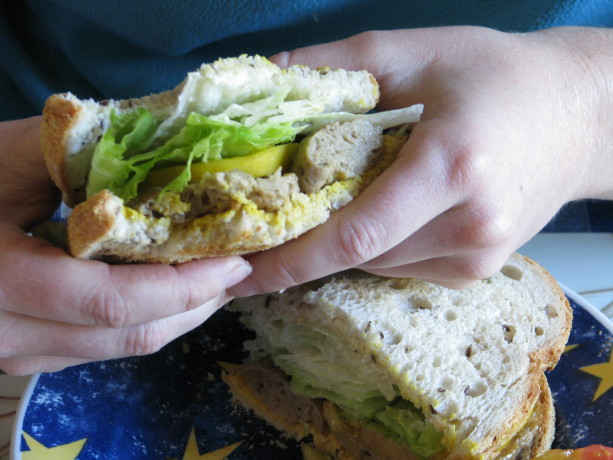
A juicy seitan sandwich is really, really good. For the past year I’ve been making my own vegan meat out of organic vital wheat gluten. This meat is called seitan (pronounced, humorously enough, say-tan, just like the fork-tongued guy in red). If you’ve eaten mock meats, especially in restaurants, you’ve most likely have eaten seitan.
I am not gluten intolerant, and I know that the current ‘epidemic’ of celiac disease is not what it seems. People eat far too much wheat in their diets, and that wheat is not only genetically modified, but sprayed with herbicides and pesticides, then processed until it has to have nutrients added back onto it to qualify as food, and then it is shipped and stored. The consumer has no idea when that poor tortured grain actually came forth into this world. As my good friend Bill says, “You can’t see the farm in it.” I believe that when people eliminate wheat from their diets they feel so much better because they aren’t eating all those hamburger buns, batters, snacks and other empty-calorie foods. They are also reducing the amount of pesticides and herbicides they consume.
I know about developing an intolerance to food. I’ve developed an intolerance to soy milk (organic, mind you), which made me realize how much of it I have been consuming. Now I drink rice milk or water mostly, and manage my soy intake while keeping an eye out for other products I may be indulging in too much. My grandfather Walter Brower in the 30’s had developed a bad dermatitis. He was in the hospital with it, being treated for all kinds of things with no relief. He was missing work, and he was the sole supporter of his family. Finally someone recommended that he visit a chiropractor… a chiropractor? For a skin condition? In the 1930’s? This was radical thinking. Thankfully he was desperate enough to go. He visited the chiropractor’s office, sitting across from him at his desk, and told the doctor about his affliction. The chiropractor asked what he did for a living. My grandfather was a delivery man for Bordon’s milk. The chiropractor said that my grandfather had developed a milk allergy due to all the dairy products he consumed. My grandfather went off dairy, and the skin problem disappeared within days. (This was at a time before cows were fed pellets of corn and chicken feces laced with antibiotics as they are today, too.)
All that said, I make my own meat with organic products, as well as my own vegan butter , and am now experimenting with vegan cheese (more on that later). Do I have a lot of time on my hands? No. I spend a couple hours once a month making the seitan and the butter, enough for a month, and freeze both.
Seitan isn’t pretty before it is cooked. It is grey and spongy. However compare it to the flesh of a butchered animal and it is beautiful. You can buy vital wheat gluten just about anywhere now, but different brands have different quality. I use Bob’s Red Mill which has outstanding flavor and never gets rubbery. I also use Bragg’s Liquid Aminos instead of soy sauce, tamari and often other salt. It is organic and nutritious, and a little bit brings out the flavor of soups, main dishes, salad dressings, scrambled eggs, and anything its added to. Compare prices online for both; Amazon.com has good deals if you want to buy a lot.
When seitan is frozen, the patties are quickly thawed in a lightly oiled pan. The ‘meat’ is juicy, flavorful and delicious, and can be used in place of chicken strips, ground up instead of meat for stuffing or sausage, used as is in a sandwich or hamburger, or cubed for stew, curry… whatever. The problem I have is wanting to eat it too often!
Basic SeitanAuthor: Originally from ShrimpGhost on Allrecipes.comRecipe type: Main DishCuisine: VeganPrep time:Cook time:Total time:Serves: 12Organic vital wheat gluten makes a yummy, all-purpose meat substitute for very low cost.Ingredients- 2 cups organic vital wheat gluten
- 1 teaspoon organic crushed dry rosemary (or minced fresh)
- 1 teaspoon organic dried thyme
- 1 teaspoon organic dried rubbed sage
- ¼ teaspoon organic cumin seed, lightly crushed
- ¼ teaspoon organic garlic powder
- 2 cups water
- ⅓ cup Bragg's Liquid Amino Acid (or tamari sauce, but it is saltier)
- 8 cups water
- ¼ cup tamari sauce
- ¼ cup Bragg's Liquid Amino Acid
- ½ teaspoon organic onion powder
- 1 4-inch piece dried kelp (kombu) (you may omit)
Instructions- In a large non-reactive bowl, mix together the vital wheat gluten, rosemary, thyme, sage, cumin seed and garlic powder. In a measuring cup mix the 2 cups water with the Bragg's. Quickly add the liquid to the dry and working fast mix thoroughly. The gluten will develop quickly; use your hands to work it to make sure there are no patches of dry gluten. There should be extra liquid. The gluten will be rubbery. Shape the gluten into a long loaf, about 3 inches in diameter. Allow to rest while you make the broth.
- In a tall stock pot combine 8 cups of water with the Bragg's, tamari, onion powder and kombu and bring to a boil.
- Cut gluten log into slices no wider than ¼ inch, or in strips (you can always cut the finished patties into strips later). Individually drop pieces into boiling stock (they'll stick together otherwise). Reduce heat to low, cover and simmer for 45 minutes. Drain and either store seitan in refrigerator in some broth for no more than 5 days, or layer seitan patties flat in a plastic freezer bag laid on a cutting board or plate and freeze. When frozen gently break apart patties in the bag and keep frozen, taking out what you need. Patties can be heated quickly in a pan, sliced and stir-fried, thawed and breaded and baked or fried, or used any way you'd like.
I tried several seitan recipes, most of which were either too bland or too strong and muddy flavored. This recipe I really like for all-purpose, chickeny seitan. I freeze the finished slices flat in a plastic bag so I can pull out however many I need whenever I want them.
